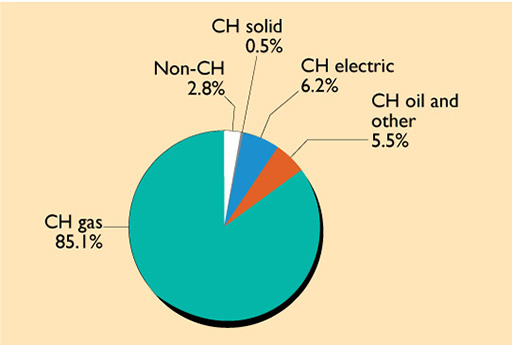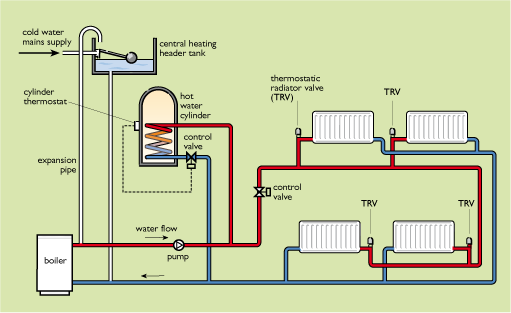3 Improving heating system efficiency
Over the past 60 years the UK has been transformed from a country where the majority of homes were heated with individual coal fires to one where central heating is almost universal. In 2014, an estimated 97% of British homes were centrally heated.
An open coal fire may seem very cosy and traditional, but in practice most of the heat disappears up the chimney. The thermal efficiency of a heating system = useful heat output / fuel energy input. That of a coal fire is particularly low.
Table 9 illustrates the enormous variation in thermal efficiencies of different space heating systems.
| Heating system | Seasonal average efficiency |
|---|---|
| Open coal fire | approx. 32% |
| New coal boiler | approx. 70% |
| Electric fire | 100% |
| Older gas fire | approx. 50% |
| Typical 1980s wall-hung gas boiler | approx. 65% |
| Gas condensing boiler | >85% |
In the UK, gas is the dominant central heating fuel (see Figure 27) and it also supplies half of non-centrally heated homes. Renewable energy and energy from waste meet about 1% of domestic heating energy demand.
This growth of central heating use has been a mixed blessing for overall energy demand. The average UK dwelling today is better insulated than its 1970 counterpart, and space heating system efficiencies have increased, from an average of about 50% in 1970 to over 80% in 2011 (BEIS, 2013). It might therefore be thought that the space heating demand of the average UK home would have fallen dramatically. However, much of the potential energy saving has been taken up as increased internal temperatures. Homes are now better heated and estimated average internal temperatures have risen from about 12°C to 18°C over the same period, increasing the heat losses. It is even possible that this temperature trend will continue in the future to levels of 22°C or more found in housing in Germany and Scandinavia.
Figure 28 shows the layout of a typical domestic wet central heating system. Water is circulated through a boiler, which may be fuelled by gas, oil or solid fuel (or even an electric heat pump). The heated water flows through the radiators as well as through a heat exchanger in a hot water storage cylinder, which holds the domestic hot water used for washing, etc. The storage cylinder (if present) should be well-insulated – most are now supplied with a sprayed layer of foam insulation.
There are many variants of this basic system. The most common one is the combination or ‘combi’ boiler. This supplies heat to radiators but dispenses with the hot water cylinder, acting as an instantaneous heater for domestic hot water.
Such a system should obviously be properly controlled for maximum efficiency. A good system is likely to be controlled by:
- preset time switches, or a timing programmer
- a room thermostat that senses the air temperature, usually somewhere in the middle of the house
- a hot water cylinder thermostat that senses the requirement for domestic hot water.
In addition individual radiators should be equipped with thermostatic radiator valves (TRVs) that provide extra local control in individual rooms.
Systems for larger buildings are likely to follow a similar pattern, but may have multiple zones that can be separately controlled. Large buildings such as hospitals are likely to use ‘warm air’ heating. Air is centrally heated (or cooled) and then blown through ducts to individual rooms.


